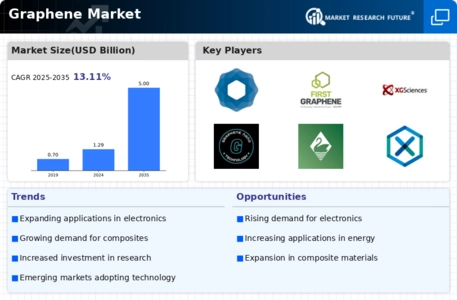Top Industry Leaders in the Graphene Market

Graphene Market
Graphene, the "wonder material" of our time, is no longer confined to the pages of research papers. Its unique blend of strength, conductivity, and flexibility is rapidly transforming diverse industries. This dynamic landscape is teeming with established players and nimble startups, all vying to unlock the full potential of this atomic marvel. Let's delve into the strategies driving this growth, explore the factors influencing market share, and unveil the recent developments painting a vibrant picture of graphene's future.
Strategies Building a Graphene Empire:
-
Product Diversification: Beyond traditional powders and flakes, leading companies like XG Sciences and Graphene Flagship are expanding into pre-coated fabrics, high-performance films, and even composite materials, catering to specific application needs. -
Technological Advancements: Pioneering new production methods like chemical vapor deposition (CVD) and scalable roll-to-roll processes, as seen in Nansulate's offerings, are crucial for increasing graphene yield and reducing costs. -
Focus on Sustainability: Utilizing eco-friendly production methods like microwave exfoliation and waste biomass valorization, as seen in Graphene Nanotechnologies' initiatives, are becoming key differentiators in a resource-conscious market. -
Regional Expansion and Localization: Entering high-growth markets like China and India, coupled with adapting products to local regulations and manufacturing capabilities, is key to success. Samsung SDI's strong presence in Asia exemplifies this approach. -
Strategic Partnerships and Collaborations: Collaborations with research institutions, technology giants, and end-use manufacturers enhance knowledge sharing, accelerate innovation, and secure market access. Graphenea's partnerships with car manufacturers showcase this strategy.
Factors Forging Market Share Fortresses:
-
Brand Reputation and Quality: Established players with a proven track record of quality and consistency, like ACS Materials and Graphene Labs, hold an edge over newer entrants. -
Production Capacity and Scalability: Large-scale production facilities and scalable manufacturing processes ensure cost-effectiveness and timely delivery, giving established players like Graphene Manufacturing Group a competitive advantage. -
Innovation and Technological Prowess: Pioneering new applications like graphene-based batteries with superfast charging capabilities, flexible electronics, and even water desalination membranes, as seen in Stori's offerings, fosters market distinction. -
Price Competitiveness and Regional Considerations: Cost-effective solutions for mass markets in emerging economies like India and China can offer companies like NanoXplore an edge. -
Marketing and Customer Service: Engaging marketing campaigns showcasing the game-changing potential of graphene across diverse industries, coupled with impeccable customer service, are crucial for brand loyalty and repeat business. Graphene Nanotechnologies' focus on customer service sets them apart.
Key Players
- CVD Equipment Corporation
- Vorbeck Materials
- Graphene NanoChem
- XG Sciences Inc
- Angstron Materials Inc
- Graphene Laboratories Inc
- BGT Materials Limited Ltd
- Graphene Inc
- Grafold Inc
- Hausale Limited, among others
Recent Developments
November 2021: NeoGraf Solutions, a leading inventor and manufacturer of graphite, has announced that it has started producing graphite (GNP) materials under the Graf-X brand. Thermoplastic and thermoset applications are the company's main areas of concentration. According to the business, it can produce about 750 metric tonnes of GNP material annually. Its graphite precursors (GP), which amount to about 1,300 tonnes, are made of graphite and intended to transform graphite materials efficiently. The graphite that NeoGraf produces is made in Lakewood, Ohio.
November 2021: A lithium-sulfur battery for electric vehicles with enhancement has been launched by the California-based business Lyten. The battery has a higher gravimetric energy density than conventional lithium-ion and solid-state technologies. It is commonly known that the corporation has collaborated on military projects with the US government. The LytCell EV product was created to provide three times the energy density of traditional lithium-ion batteries. The Li-S battery lacks nickel, cobalt, and oxygen from metal oxides. The batteries can be produced in prismatic, envelope, and cylindrical shapes.
July 2022: Together, Graphenea and Grapheal developed GraphLAB, a graphite-based tool, to fact-track the investigation on biosensors. A cutting-edge evaluation technique for protein disease and screening detection is GraphLAB.
July 2022: Haydale Graphene Industries PLC collaborated with Vittoria SpA – a company that produces tires for performance bicycles, on joint development and supply of functionalized graphene nanomaterials along with bicycle tire rubber. In this regard, Haydale received an order for one ton of functionalized graphene material. Medium-term plans were also reached between these two companies to produce functionalized graphene material near Vittoria plants in Thailand.
March 2022: GMG (Graphene Manufacturing Group Ltd) signed a non-binding Letter of Intent (LOI) with Amec Foster Wheeler PLC about their major GMG’s graphene manufacturing expansion projects. Here, Wood would assist GMG in scaling up and automating its proprietary natural gas to graphene manufacturing process.
In August 2022, NanoXplore announced that it had acquired XG Sciences’ assets. In accordance with the agreement, NanoXplore will acquire XG’s research development facility, milling platform, patents, and trademarks.

